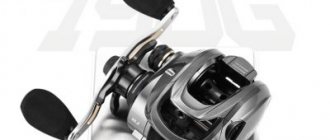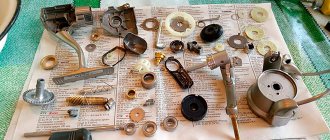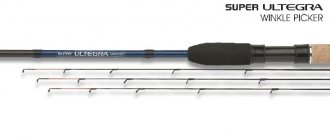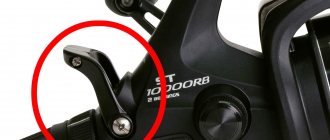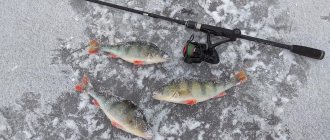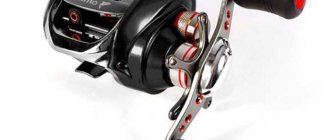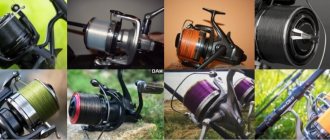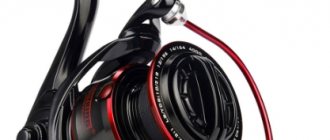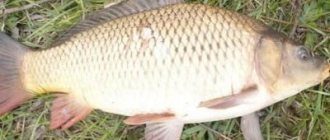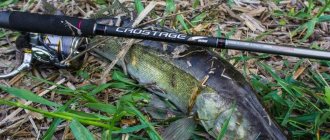Why do you need an inertial coil? What tasks of a spinning rod does it cope with better than a spinning rod? You will find answers to these and other questions in this article.
The operating principle of inertial coils is based on the operation of a wheel drum rotating by inertia. The reel is the main part of any spinning rod.
The main purpose of the inertial coil
- Fly fishing. For an introduction to this type of fishing, read the Beginner's Guide to Fly Fishing.
- Fishing with a Bolognese fishing rod. The Bolognese fishing rod is a tackle consisting of a rod with rings, usually 5-6 meters long, and a small inertial reel. You can read more about the classification of float rods and fishing methods here.
The quality of the reel affects the process of winding the line and storing it, as well as landing fish when it comes to fly fishing.
There are two types of inertial coils:
- simple drums;
- cartoon.
Multiplier inertial reels
- functional;
- reliable;
- have flexible brakes;
- the best on the market.
Types of multiplier reels:
- classic;
- low profile.
When fishing at great depths, reels use counters.
Classic reels - “barrels” are similar to a small winch that can hold a lot of fishing line.
Heavy reels are used for large bait when fishing for large fish.
Low-profile baitcasting reels are designed for lightweight bait based on their technical characteristics.
A modern baitcasting reel “steps on the heels” of a spinning reel in cases of easy, long-distance casting. It is reliable and powerful, suitable for catching very large sea fish.
A multiplier reel is used on almost all gear, but most often when fishing with a spinning rod, combining well with a standard or short fishing rod.
Instructions on how to cast a spinning rod with an inertial reel
Casting gear with an inertial reel, including a multiplier, is done more gently than with a meat grinder, although the technique is identical - vertical, pendulum, side. We wrote about these methods in the article “Fishing with a spinning reel depending on the conditions and fishing method.” While throwing from the side is not difficult, throwing from behind the back of an inexperienced angler often ends in a beard.
How to cast a tackle far from an inertial reel depends on several characteristics, including the structure of the blank and its length, as well as the weight of the bait. Not all fishermen realize how much strength their rods have, trying to cast the equipment carefully, for fear of breaking it.
In principle, this is true, but not entirely. To get the rod to work to its full potential, you need to apply enough force to it to accelerate it to maximum speed when casting. But caution is necessary, since each form has a limit to the test range, beyond which there is no reason to cross.
How to properly cast a spinning rod with an inertial reel from the side
- when casting right-handed, the reel is located above the blank, when casting left-handed, it is under it;
- the bait is placed on a hanging line with a distance to the tip of 0.2-0.3 m;
- the scaffold is pressed against the form with a finger, the brake is turned off;
- the form is pulled back, then in a smooth movement, with acceleration, it is sent forward. The trajectory of the rod is from bottom to top, at the right moment the line is released.
How to properly cast a spinning rod with an inertial reel from behind you
- when trying to cast, you shouldn’t push the form too hard;
- at the moment of throwing, you do not need to make maximum effort;
- the bait should go into the pond in a wide arc.
If the gear is correctly selected and the technique is sufficiently worked out, throwing a small bait weighing 30 grams over a hundred meters will not be difficult. Even pickers weighing twenty grams can be cast at the same distance, and heavier baits can be cast even further.
Competitions are often held among athletes on how to throw a spinning rod with an inertial reel over extremely long distances, called casting. The world record is 132 meters, the weight of the load is 18 grams. With proper training, it is possible for an amateur to achieve similar results, but not necessarily. It is much more important to achieve casting accuracy.
A few more tips for the novice fisherman:
- You don’t need to put maximum effort into casting, you need to do it smoothly and progressively, otherwise a beard is guaranteed.
- Just before the bait touches the pond, you need to smoothly slow down the drum, while simultaneously lifting the form up.
- When guiding the bait, set it at different speeds and trajectories to imitate the natural movements of the fish.
It is widely believed that the inertial coil is an atavism of bygone days. Quite a controversial issue, for example, old fishermen catch fish very effectively with the help of inertia. So if you approach any issue competently, success will be guaranteed.
Advantages and disadvantages of inertial coils
Let's start with a video by the Shcherbakov brothers, which provides an overview of multiplier and inertial reels, as well as their characteristics and features.
Advantages of simple multipliers:
- simplicity of design;
- acceptable price;
- inertia.
Disadvantages of simple multipliers:
- heavy drum;
- When casting light baits, the line often gets tangled.
Advantages of “advanced” baitcasting reels:
- inertia;
- the ride is smooth and easy;
- brake;
- reverse stop;
- winding speed;
- material;
- weight.
Application area
- fishing with large bait;
- opportunity to fish for large fish (up to 60 kg);
- long cast
Flaws:
- high price;
- difficulty to use (you need to get used to it);
- heavy rod;
- difficult setup.
Conditions for using the inertial coil
The main types of application of inertial reels are float and spinning fishing, where this mechanism was able to reveal most of its advantages. In fly fishing, this accessory is the basis of the gear and affects the course of the entire fishing, regardless of the fishing strategies used. In spinning hunting for predatory fish, this type of reel is already inferior to inertia-free options, but only in active fishing methods.
It is more convenient to carry out such types of spinning fishing as trolling with multiplier reels, which are a modernized version of the same inertial reel. And it is more reliable to work with a spinning rod with equipment of a large mass using an inertia, which is less susceptible to the influence of overloads and is not afraid of wear of the mechanism that ensures the rotation of the drum.
How to choose a spinning reel
To choose a suitable inertia-free reel, you need to look at the main characteristics.
Spinning reels differ in the size of the spool, which can range from 1000 to 4000.
- 1000 (the spool contains 100 m of fishing line, 1 mm in diameter).
- 2500 (the spool contains 100 m of fishing line, 2.5 mm in diameter).
The main task of an inertia-free reel is to lay the line evenly.
There are several types of winding:
- cylindrical (the line line is straight, runs parallel to the edge of the spool),
- reverse or straight cone (the line line is straight, at an angle to the edge of the spool).
This is interesting. When fishing with a jig, it is better to take a braided line, which uses winding the line onto the spool at an angle to its edge. This will prevent it from flying off and getting tangled.
- When buying a reel, pay attention to the capacity of its spool. 80 meters must be included.
- Give preference to a reel with an easy stroke. As many rotations as possible after the jerk are better.
- The reel must have reliable line guide brackets to firmly secure the line when open.
- The number of ball bearings on a quality reel should be 5-6 pieces.
- It’s better to take a factory branded one; SHIMANO and DAIWA can offer reels at an affordable price.
- The presence of a friction brake, two types:
- Front – located in front of the spool, sensitive, light weight.
- Rear – located behind the reel, it can loosen or tighten the clutch, convenient when fishing for large fish.
When choosing a spinning reel, pay attention to the following points:
- What material is it made of (plastic or metal), combined reels are better, since plastic ones are short-lived, a good reel is made of light alloy metal.
- A full revolution of the handle to the number of revolutions of the line layer is the so-called gear ratio (TR). Based on the magnitude of the IF coils, they are divided into high-speed and power.
- Weight and size of the reel: as practice has shown, the following rule works - the weight of the reel should be equal to the weight of two fishing rods.
- Friction brake - automatically releases the fishing line and protects it from tangling during sudden movements.
- A spool is a storage device for fishing line; it is better to take a metal one; such a spool is suitable for both fishing line and cords.
- Four to six bearings.
- Reel handle - the best reel is one in which the handle is folded with a screw.
- Brands, the most popular brands are Japanese SHIMANO and DAIWA, European MITCHELL, ABU GARCIA, SPRO.
Characteristics and differences of inertial coils
Content
The gear mechanism is extremely simple, it consists of the following elements:
- frame. It comes in plastic and metal. Sometimes plastic models are not inferior to metal ones;
- inertial drum options include a drum of various sizes; it is selected depending on the size of the fish, casting distance and type of rod. Large reels are used for catching catfish, carp and other large fish, but they are impractical for active fishing and are only suitable for bottom gear. A fishing line from 50 to 300 m is wound on the drum;
- The drum axis is equipped with bearings and cones. Inertial spinning reels on bearings are durable and wear-resistant;
- fastening;
- stopper The device is equipped with a ratchet that moves in one direction and blocks reverse movement. Modern ratchet models last for many years;
- classic ratchet brake. Models with a brake and ratchet are convenient to cast and use for landing fish.
An inertial fishing reel is designed extremely simply.
The bait, due to its flight, creates inertia, which sets the reel in motion. The line is fed directly from the reel. Spinning reels prevent spinning during casting. They are in demand among spinning anglers due to the possibility of long casting of the rod.
The cost of the reel depends on the materials used for its manufacture: aluminum, titanium, stainless steel, duralumin. “Inertia” is often taken from light aluminum alloys. Another important factor is the size of the coil. Fishing with bottom gear is carried out with reels of 100, 150 mm; they are convenient for spinning fishing in places with underwater vegetation. Smaller sizes are used when hunting small fish that live in the upper layers of water.
When choosing a reel for a beginner, it is important to look closely at the reliability of the drum and the presence of bearings. Other characteristics: method of laying the fishing line, number of built-in bearings, metal body. The listed properties are not so important, and often useless.
How to choose a reel for a spinning rod
Before choosing a reel, decide on your goals:
- What kind of fish will you fish for (small or large).
- What body of water will you fish in (river, lake or sea).
- What time of year will you fish (winter, summer, off-season).
As mentioned earlier, high-speed reels with easy rotation can be used for catching small fish. The bait should be light and maneuverable. This reel is well balanced and does not vibrate, is designed for long casting, has a mechanism, as well as a double handle for better balance. The rear brake acts as an additional lever, reducing the effort required.
Power reels are usually used when fishing for large specimens. The line roller has a large diameter and is very helpful in withstanding heavy loads when fishing for fish. There are rollers that move and rotate on a bearing, the most durable ones are coated with titanium nitride.
It is important! When purchasing an expensive power reel, do not forget about a spare spool.
Modern technologies in the manufacture of inertia-free motors
If we consider the reasons why some anglers do not accept inertial reels, then one of the main ones is the simplicity of the mechanism. The wheel is strung on a cylindrical axle, it is impossible to make a long-range cast, and even when choosing a line the speed is low.
However, the apparent simplicity has its considerable advantages, for example, low sensitivity to moisture and dirt. If foreign objects penetrate inside, it is enough to dismantle the drum, wash and dry all the elements - and the reel is ready for battle again. For high-quality devices, the axles and bushings are made of good metal and carefully matched to each other.
To increase the performance of such models, as well as to increase wear resistance, the mechanism is equipped with a ball-type bearing, which is mounted on the axle and is fixed to the drum with its outer diameter through the hub. Modern inertia engines are made on a cone, that is, the cone is formed by the axis itself.
In their manufacture, high-carbon steel is used, and the axis itself is very carefully ground. The bushings are cast from another metal - bronze, and they are pressed into the hubs. Such mechanisms operate completely silently.
Manufacturers are not limited to just one bearing; they can often be found on both sides of the axle. Such devices have a very soft stroke, while the equipment can be thrown over very decent distances, and the reeling speed is at the proper level.
Even a slight complication of the mechanism leads to increased accuracy during handling. It is not recommended to allow water and sand to penetrate inside, otherwise the coil may be damaged. If this happens, it is necessary to lubricate the bearings, or, in extreme cases, replace them. Fly fishing requires special care, as we wrote about in the article “Classes of fly fishing reels depending on the rods.”
Cheap or expensive?
Reels at a higher price have a fluoroplastic bearing sleeve, which improves roller rotation and provides resistance to loads.
When choosing, don’t be lazy, look at the data sheet. Your reliable companion on every fishing trip will be a reel that has a gear with wide, large teeth and additional emphasis on the small gear.
Reels of size 2500 will allow you to quickly cast the bait and keep it in the pond for a long time.
For large fish, use a 3000 reel, suitable for a spinner weighing from 10 to 50 g. For catching very large fish at depth or in places with strong currents, a 4000 reel with a spinner weighing 45 g is suitable.
An important factor when choosing a spinning reel is the number of bearings. Four pieces are enough.
The next factor is the material from which the reel is made. Graphite and metal are better. Plastic reels are not durable.
Beard on reel
The beard is the main disadvantage of inertial coils
The heavier the load, the less often a beard appears on the reel. When casting heavy feeders of 50-100 g, the load continues to pull the line even after the feeder falls into the water and very rarely there may be a small beard on the reel. When casting heavy spinners (jig heads) 30-40 g, the load pulls the line until it falls into the water, and to prevent beard from appearing, you need to lubricate the reel. When casting light baits, such as 10-15 g wobblers, the weight pulls the line to the top casting point, and beards often appear.
If you miss the moment of drum braking, a beard appears.
The thicker the forest, the easier it is to untangle your beard. The tougher the wood, the easier it is to untangle your beard.
Beard Detangling:
1.1. stop the reel
1.2. tighten the lure so that the line is free without tension
2. If the beard is not very large:
2.1. carefully trying not to mix the rings, remove the beard from the reel
2.2. move your hand with the tangled line away from the reel, a small beard will immediately untangle
2.3. if the hand retraction distance is not enough, you need to put the reel down and move away from it with the tangled line
3. A more complex beard can be untangled by stretching it, trying not to tighten the knots in the beard, you need to stretch the line with your hands in different directions, up to the full span of your arms (with this stretching, the tangled rings of the line come out of each other
4. If the beard is very complex, you will have to untangle the line - by releasing the loops, threading them through the tangled line and winding the loops onto sticks
5. After untangling the beard, the line must be stretched
Detangling your beard can take quite some time. A complex beard on a reel can only be untangled at home. If there are no spare gear (reels, fishing lines, spinning rods), the fishing will be ruined.
You can use inertial reels for fishing on spinning rods, when trolling, and when casting heavy baits with a spinning rod.
One of the types of inertial coils are multipliers. In Soviet times, craftsmen made a multiplier from a Neva coil, installing a gearbox and a handle. Domestic Orion multipliers were also produced.
Modern baitcasting reels are used, for example, when trolling and when catching large fish (catfish).
inertial coil - multiplier
A powerful multiplier reel allows you to pull out a catfish weighing several tens of kilograms.
multiplier reel with line counter
Inertial fishing reels are quite varied, there are small and large, budget and quite expensive. When choosing a reel, you must first of all proceed from the conditions of the upcoming fishing.
The best inertial reels
The best inertial reels are models from well-known Japanese companies SHIMANO and DAIWA.
The model range is varied in price, appearance and technical characteristics.
SHIMANO EXAGE
- reel for beginners;
- low price;
- decent quality.
SHIMANO BIOMASTER
- reel for professionals;
- middle class;
- average price is about 7 thousand rubles.
SHIMANO TWIN POWER
- upscale;
- for professionals;
- price from 10 thousand rubles.
The best DAIWA models
DAIWA CROSSFIRE
- First level;
- price from 2 thousand rubles.
DAIWA CERTATE
- - high level;
- – price from 17 thousand rubles.
Technical characteristics of the best baitcasting reels:
- – gently rotating drum;
- – solid frame;
- – comfortable handle;
- – high-quality assembly.
The most “advanced” baitcasting reels have powerful traction and high reliability.
Their features:
- - braided fishing line;
- – durable spool;
- – wear-resistant line layer insert;
- – cross-shaped cord winding;
- – anti-reverse;
- – comfortable grip;
- – easy start pedal.
What types of inertial coils are there?
Based on the type of fishing to be done - from the shore, from a watercraft (boats, boats, etc.), certain types of inertial spinning reels are used, which are:
- drums;
- cartoon.
In addition, baitcasting reels can be classic or low profile.
Drum reels
These reels are characterized by a simple design and are used for wire fishing or fly fishing. Actually, the main element of such a device is a drum equipped with a pair of small handles. It is mounted on a holder, which, in turn, has a bracket provided by the designers for subsequent installation on the fishing rod. In order to increase efficiency during operation, the drum is equipped with a brake-ratchet system, as well as a button to activate or deactivate this function.
The best domestic drum reel is deservedly considered the “Nelma” model, produced by. An excellently balanced, durable drum, which has two bearings and a reverse stopper connected directly to the ratchet brake, is lightweight, as it is made of light aluminum alloys. The cost of the product varies from 50 to 100 dollars.
We recommend reading: Secrets of catching asp using a spinning rod
It is not recommended to purchase cheap gear from dubious manufacturers. Since high-quality equipment directly affects the final result of any fishing.
For fishermen with unlimited financial resources, it is recommended to pay attention to gear. In particular, for “Conquest” or “Bewick” reels. The cost of these tackles starts from $400, but the spinner receives guaranteed quality. Low-budget gear includes gear from China, which produces a large number of models with drums on “balls.” The reels are qualitatively inferior to “Nelma” and can only be used when catching prey from a watercraft (on board). But the cost of such products is only 25 - 30 dollars.
Multiplier reels
“Mults,” as they are affectionately called by people, are the most commonly used inertial reels for spinning rods among fishermen. The popularity of this type of equipment is explained by its versatility, high reliability and quality, and flexible adjustment of the brake system. In addition, some models have a counter that records the amount of fishing line wound, which is necessary in the process of catching predators at decent depths.
Naturally, this type of reel costs an order of magnitude more than drum equipment. However, in almost all cases, the “mult” will successfully replace the coil of any other model. As mentioned above, baitcasting reels can be classic and low-profile - the difference lies in the structure of the equipment body:
- “Barrels” or classic “cartoons” really resemble in their appearance a well-known container or winch with a spool that holds a large amount of fishing line. Heavy reels of this type are preferred for fishing, for example, Pacific tuna weighing over 200 kg. Actually, “barrels” are used for fishing with heavy bait by trolling a large predator in the sea or ocean.
- “Soap dishes” or low-profile “cartoons” involve fishing with light (ultra light) baits. The reels of this model are a real find for the spinning angler, as they are characterized by precise settings of the brake system. Of course, it will not be easy for a beginner to correctly set up the reel’s braking system, but having found the optimal ratio, the “soap box” will become indispensable on any fishing trip.
“Multi” are perfect for any fishing rod. However, most often such reels are used when fishing with a spinning rod. The ideal combination is a short one-handed or standard rod. In the case of using a “mult” on a two-handed spinning rod, it is necessary that the rod have a handle in the form of a saddle, and be equipped with a support trigger intended for the index finger.
Multiplier reels with cutting-edge design and almost imperceptibly easy action occupy a leading position. However, the gear of this famous brand has a drawback - fragility. The fact is that the plastic used in the manufacture of reels, which makes the tackle itself lighter, does not withstand physical impact well. Cost - from 70 to 180 dollars. Shimano reels are significantly heavier than competitor models, but superior to them in all other characteristics. The price is also pleasing - from 40 to 80 dollars.
Tackle from another well-known brand “Abu Garcia” has more weight than the weight of the above-mentioned models, since a minimum amount of “delicate” plastic is used in production. However, the reliability of such reels is beyond any doubt, which entails the use of gear for catching real underwater giants. The cost is also pleasantly surprising - from 60 to 90 dollars.
We recommend reading: Zherlitsa
Spinning line
Read the complete guide to choosing a fishing line for a spinning rod here.
Monofilament is used to catch most fish.
Its advantages:
- minimal friction;
- shock absorption on the bait;
- catching large fish;
- does not get tangled (will help you out when fishing at night).
For spinning reels, the suitable fishing line diameter is 0.25-0.27 mm; for inertial multipliers – 0.5-0.40 mm.
The weight of the bait is selected according to the parameters of the fishing line diameter:
- 20 g – 0.25 mm;
- 25 g – 0.27 mm;
- 30 g – 0.30 mm;
- 45 g – 0.40 mm.
If you actively use fishing line and make frequent casts, use inexpensive domestic fishing line and change it more often.
When fishing is finished, many fishermen rewind the line with the other end and use it again.
Flucarbon is a spinning line that is widely used as a leash line.
Advantages:
- has great sensitivity
- invisible to fish
Flaws:
- high price;
- low extensibility;
- reduced strength;
The more sensitive the spinning rod and the simpler the reel, the thinner the fishing line will be needed.
Learn how to properly tie line to a reel.
